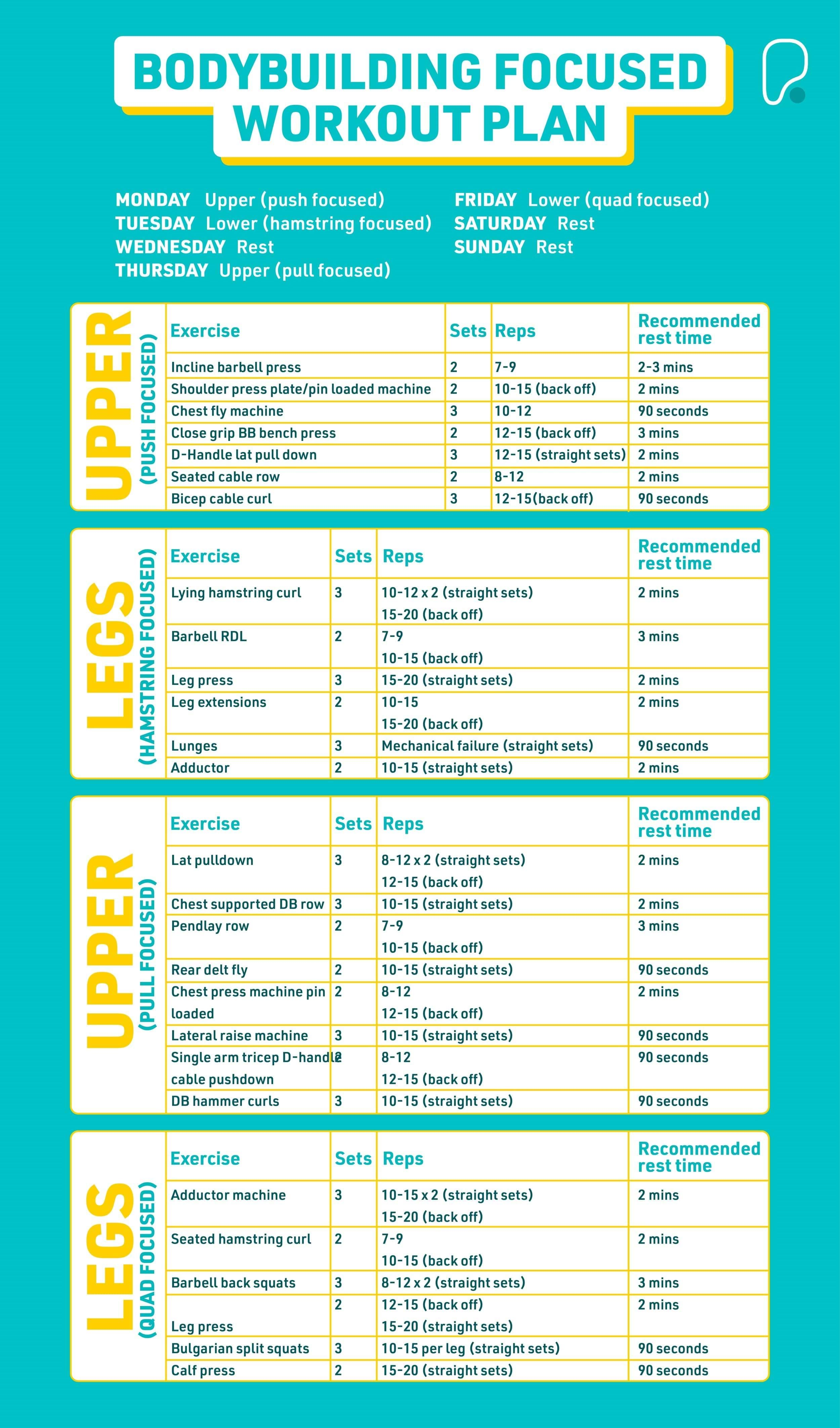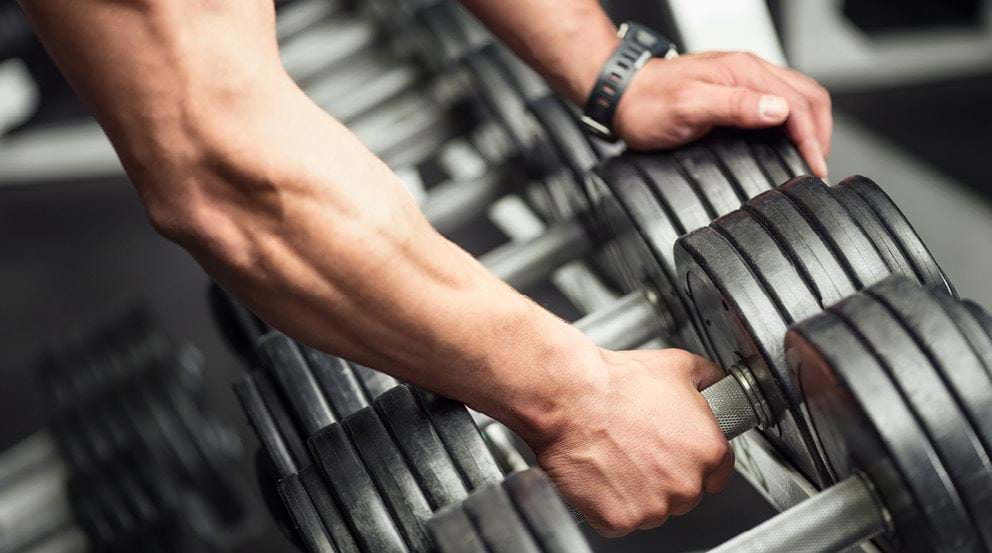A Bodybuilding Workout Plan For the Gym

What Is Bodybuilding? | Who Is It For? | Nutrition Tips | Why Make A Plan | Create Your Own Plan | Example Bodybuilding Workout Plan
Are you ready to embark on a journey towards a stronger, more muscular physique? A bodybuilding workout plan is great for more experienced lifters wanting to take their training to the next level and build muscle mass.
In this article, Ben Missons, Strength & Conditioning Coach and expert Personal Trainer at PureGym Chatham, explains the important elements that make up an effective bodybuilding plan, as well as an example workout plan for you to try.
Jump straight to the bodybuilding workout plan.
What Is Bodybuilding?
Bodybuilding is a type of strength training which focuses on building significant muscle mass to alter the physique.
Both the exercises and volume (reps and sets) are chosen to maximise hypertrophy, so training for bodybuilding can look different from other forms of strength training (such as calisthenics, strongman, powerlifting etc).
Bodybuilders will also focus on progressively overloading (increasing the weight or volume each week) to continually challenge the muscles, which helps with hypertrophy.
Most bodybuilders will also tailor their diet to achieve their chosen look, often focusing on high protein to help with gains, and calorie deficits to help achieve a lean muscular look.
In bodybuilding competitions, this can be taken to the extreme, with competitors dieting to achieve very low body fat and reveal the muscles they've built.
Who Is Bodybuilding For?
While bodybuilding can be for everyone, extreme bodybuilding (for example, prepping for competition) is unsuitable for those with prior eating disorders due to its focus on appearance and weight loss.
However, the principles of training for bodybuilding can be used by anyone in the gym who wants toned, defined muscles or to improve their body composition.
Nutrition Tips For Bodybuilding
The exact nutrition you need when bodybuilding is different for everyone. There is no 'one size fits all' diet to follow as the number of calories you eat will depend on whether you are trying to lose fat, as well as factors like age, activity levels, height, and weight.
However, a good approach to take is working out your calorie target for your goal, and then working out what balance of macronutrients (protein, carbohydrates, and fats) this should be. Carbs and protein both have 4 kcals per gram (so 10g of protein is 40 kcals), while 1g of fat has 9 kcals.
All three macros have their benefits for bodybuilding and overall health, so it's important not to cut any of these out completely:
- Protein is particularly important for bodybuilders as it provides the building blocks the body needs to repair and build muscle. Eating protein also helps to keep you full for longer.
- Carbs are the body's main source of energy, and eating enough carbs allows you to push hard in your workouts, as well as fuel recovery.
- Fats help us to feel satiated (which is very helpful when on a calorie deficit), regulate blood glucose, and keep our stress and sex hormones (like testosterone) at a healthy level.
A bodybuilding diet typically focuses on a high intake of protein. The recommended amount varies but studies tend to suggest around 0.9 -- 1.25g of protein per lb of lean body weight, so if you were 100lb this would be 90-125g of protein a day. In this example, you would eat 360-500 calories a day from protein sources, and the rest from carbs and fat.
Another way to split your calories is by doing 35:50:15 -- 35% of your calories from protein, 50% from carbs, and 15% from fat. This allows adequate protein, with plenty of carbs and fats to ensure high energy and enough fats to sustain all bodily processes. There are plenty of calorie and macro tracker apps that make it easy to calculate and track this.
Arguably the most important tip when it comes to nutrition for bodybuilding is to eat foods that you enjoy and won't get bored of. Chicken, veg and rice might be an easy macro-friendly meal, but if you get bored of it after two days and swap it for a takeaway, you won't hit your goals. Cooking with herbs and spices, swapping your recipes up to prevent boredom, and allowing treats in moderation, will help to keep you on track.
Why Is Having A Plan Important For Bodybuilders?
Some bodybuilders prefer to have a regimented plan that looks the same day in, and day out, but you can be more flexible with your approach and still make progress. However, it's still important to have a workout and nutrition plan in place, even if they're more top-level.
Having a workout and nutrition plan is important for bodybuilders for three reasons:
- Makes it easier to track progress which can help with motivation
- Makes it easier to progressively overload which is crucial for bodybuilding
- Ensures you are training each muscle group enough for hypertrophy
How To Create Your Own Bodybuilding Workout Plan
I've created an example bodybuilding workout plan below, but if you want to create your own here are my top tips.
- Start off with three to four training days per week. If you are training with maximum intensity, this is enough to stimulate muscle growth and see positive changes. Training too much can lead to overtraining, fatigue, and even injury, all which will set you back. You can always add more sessions as you grow stronger.
- Avoid working the same body part twice within a 48-hour period. Training the same muscles with less than 24 hours rest between each session doesn't give the muscles enough time to recover, meaning your workouts will be less effective and you'll be more prone to injury
We have more tips on creating your own workout plan and free workout plan templates here.
Workout Splits For Bodybuilding
Workout splits are useful for allowing you to work out on consecutive days without training the same muscle group two days in a row.
If you're working out three days a week, Push (chest, shoulders and triceps), Pull (back and biceps), Legs, known as PPL, ensures all the muscle groups are targeted thoroughly over the week. Because each workout in a PPL split works the same muscles multiple times and allows for both compound and isolation work, it's a good way to get volume while only training each group once a week.
Some studies have found that training each muscle group twice per week is more beneficial for hypertrophy. A simple four day split that works well for this would be upper (push-focused), legs (hamstring-focused), upper (pull-focused), and legs (quad focused). If planned correctly, this allows you to train each muscle group twice per week without the risk of overtraining - you can see an example plan for this below.
We cover more workout splits for gaining muscle here.
How Many Weeks Should A Plan Be?
I recommend following the same plan for a minimum of six weeks before changing anything unless you are really struggling with a particular exercise. Keeping a consistent training routine and progressively overloading is important to getting the full neurological and physiological benefits of the exercises.
After five to six weeks, a good way to assess if the exercises are working for you is to implement a three-strike rule. If progressive overload does not improve (i.e. you see no increase in reps or weight) on three occasions then I would encourage swapping out exercises at this stage or even changing programmes if you get bored.
When planning your programme, you may also want to factor in deload weeks. Some people choose to do these at set times, but a good way to approach it is deloading when you see an overall trend of reduction in performance across most exercises. Many people take deloads in a multitude of ways and there really isn't a correct perfect option, it's a case of finding what works best for you. Some like to take the week off to totally relax, however if a week off the gym doesn't feel right for you, try low-volume work. This means doing the same exercises but performing just one set with a few reps still in the tank, so you're just getting your muscles moving but not exhausting the body and central nervous system.
Either way, the purpose of the deload is to rest the body and avoid the negative symptoms associated with over-training, such as general fatigue, disturbed sleep, loss of motivation and a decrease in mood. This means you'll come back refreshed and ready for the future sessions ahead!
Do I Need To Warm Up For Bodybuilding?
Warming up before any workout helps to make it more effective, including bodybuilding. A good warm up should get the muscles warm, increase blood flow, activate the muscles, and improve mobility. One of my favourite techniques for this is a RAMP warm-up Protocol.
- R - Raise
The R in RAMP warm-up stands for Raise: raising the heart rate, core temperature, blood flow and muscle elasticity. We do this by doing any low-intensity cardio on a piece of exercise equipment (whatever you prefer). This will prepare you physically and mentally for the workout. I recommend 5-10 minutes.
- AM -- Activate & Mobilisation
The Activate and Mobilisation phase of the warm-up focuses on engaging the muscles for the upcoming session as well as using similar movement patterns to the training programme ahead. The easiest way to do this is via dynamic stretching of the muscle groups and some resistance band work.
- P- Potentiation
The final stage of the warm-up is Potentiation, although normally emitted during regular training it can still be a very beneficial finisher before you start your workout. Moving on from the mobilisation phase you can become even more movement specific and use similar movement patterns to the workout ahead in order to prime your body and muscles. For instance, if you're planning to back squat in your programme, after the Raise, Activate and Mobilisation phases, you could include light goblet squats to prime and prepare your body. Obviously, at this stage you wouldn't be giving 100% or going ridiculously heavy, just preparing your body for the movement.
How Many Exercises, Reps, And Sets To Include In Your Bodybuilding Plan
There is no set number of exercises, reps or sets you need to do when doing bodybuilding. Doing three sets of 8-12 reps is widely accepted as a good benchmark for hypertrophy, but the most important factor is that you are giving it all in your workout and recovering in between sessions. I prefer a lower volume varied rep range, with around two to three sets of five to eight exercises for a total of 15 to 20 sets per workout.
Rep ranges are a very disputed topic in the bodybuilding industry -- some British bodybuilders prefer to train until failure with each set while other bodybuilders train to reps in reserve. Both approaches have their benefits but if you're new to training or bodybuilding training, I'd recommend training until mechanical failure. Mechanical failure is the act of completing reps until the muscle is so fatigued it can no longer contract. For example, for a rep range of 10 to 12, you'd want to choose a weight which you'll mechanically fail between the 10th and 12th rep.
Strict form is very important -- it helps to isolate the muscles and prevent injury. If you cannot complete a rep with good form, this also classes as going to failure.
Bodybuilding Training Strategies
As a bodybuilder, you'll use a multitude of rep ranges going from as low as 7 reps to upwards of 20 reps to ensure you hit the full strength curve and gain both strength and hypertrophy. There are several strategies that can be used to maximise results:
- Top set/ back off approach
This strategy involves working up to the top set (heavy weights, lower reps) after using feeder sets to warm up. Lifting heavy for a reduced rep range (around 7-9) is hard to replicate for multiple sets, especially if reaching mechanical failure. To ensure that enough volume is lifted and the muscles are adequately fatigued, this top set is followed by a lighter 'back off' set. The intensity and set up is the same, but the weight is reduced by around 20% and rep ranges increased.
This approach combines the benefits of heavy lifting to build strength and the benefits of volume training to promote hypertrophy. It allows you to push yourself to the limit while still providing adequate recovery and reducing the risk of overtraining and injury.
- Straight sets
I'd also recommend including straight sets within your plan - this is where the same weight is replicated during all the sets with no reduction. This means you can start with higher reps, which you take through to mechanical failure each time, and just drop the number of these as you move through each set. For example, if you have 3 sets of 10-15 reps then your first set will be closer to the 15-rep range mark and proceeding sets, if working to mechanical failure, will be slightly reduced as the muscle becomes fatigued:
- Set 1 -- 15 reps
- Set 2 -- 13 reps
- Set 3 -- 10 reps
As the sets progress, muscular fatigue will start to rise and therefore reps will be harder to complete and therefore reduce.
- Rest times
Rest times between sets should be long enough that you can recover from the previous set without being so long that your body loses muscle tension.
I'd suggest between one and three minutes of rest between sets, depending on when you feel ready for the next round and can give your all. For heavier compound movements, rest times closer to the three-minute mark may be needed, whereas smaller isolate movements may need less time.
Example Bodybuilding Workout Plan
Here is an example workout plan you can follow:
- Monday - Upper (push focused)
- Tuesday -- Lower (hamstring focused)
- Wednesday- Rest
- Thursday -- Upper (pull focused)
- Friday -- Lower (quad focused)
- Saturday - Rest
- Sunday -- Rest

Upper - push focused
- Incline barbell press
- Shoulder press plate/pin-loaded machine
- Chest fly machine
- Chest fly machine
- Close grip barbell bench press
- D-Handle lat pulldown
- Seated cable row
- Bicep cable curl
Legs - hamstring focused
Upper - pull focused
- Adductor machine
- Seated hamstring curl
- Barbell back squats
- Leg press
- Bulgarian split squats
- Calf press
Lower - quad focused
- Adductor machine
- Seated hamstring curl
- Barbell back squats
- Leg press
- Bulgarian split squats
- Calf press
If you're ready to start on your bodybuilding workout plan, you can find a PureGym near you and become a member today. Our gyms are filled with high-quality weights machines and free weights, so you can start getting stronger either on your own or with one of our expert personal trainers.


